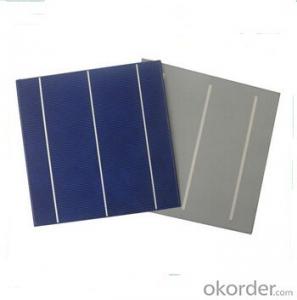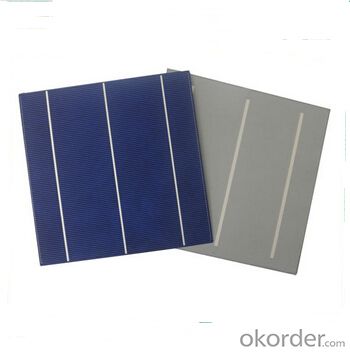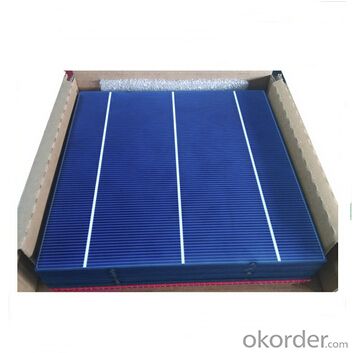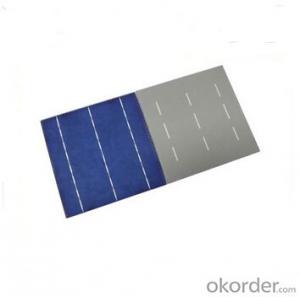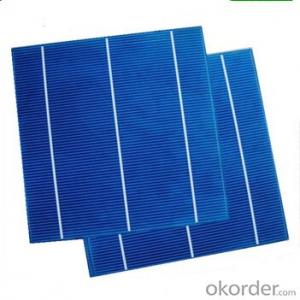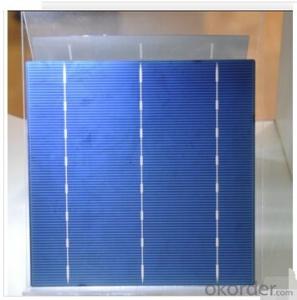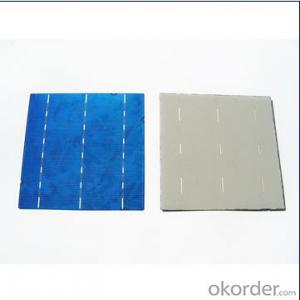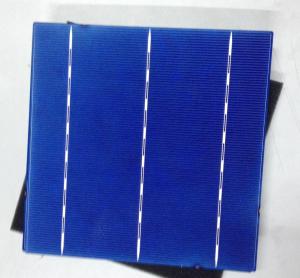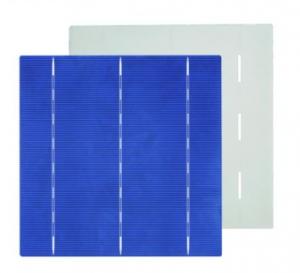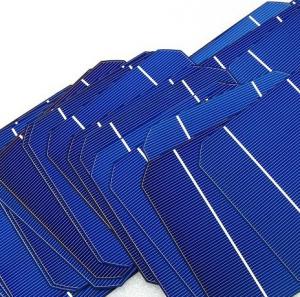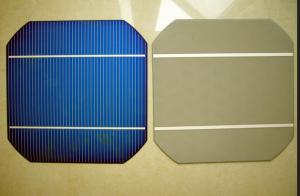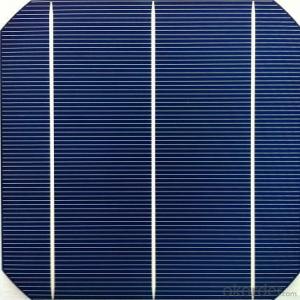Flexible Polycrystalline Solar Cells Series- 17.6%
- Loading Port:
- Shanghai
- Payment Terms:
- TT OR LC
- Min Order Qty:
- 1000 pc
- Supply Capability:
- 100000 pc/month
OKorder Service Pledge
OKorder Financial Service
You Might Also Like
Solar Cells:
Solar cells is made by solar wafer, it has three categories of solar cell right now, monocrystalline polycrystalline and thin film,These cells are entirely based around the concept PN junction, which is the critical part of solar module, it is the part that can convert the light energy into electricity, the thickness is from 180um to 200um, with even busbars to conduct electricity, textured cell can decrease diffuse reflection; they are often electrically connected and encapsulated as a module. Photovoltaic modules often have a sheet of glass on the front (sun up) side, allowing light to pass while protecting semiconductor wafers from abrasion and impact due to wind-driven debris, rain, hail, etc. Solar cells are also usually connected in series in modules, creating an additive voltage. Connecting cells in parallel will yield a higher current;With high quality and stable quality. Our Cells can greatly improve the performance of Solar Modules.
Features:
1. High conversion efficiencies resulting in superior power output performance.
2. Outstanding power output even in low light or high temperature conditions
3. Optimized design for ease of soldering and lamination
4. Long-term stability, reliability and performance
5. Low breakage rate
6. Color uniformity
Solar Cells Advantage:
1. Tire-1 Solar Cells’ Manufacturer Quality Guarantee. With a complete and sophisticated quality government system, our Quality Management have arrived world’s leading place. Customer can receive Tire-1 Cells Maker’s Quality Standard Products.
2. Trusted Warranty. We can supply trusted after-sales service to our customer. If our cells are found not in conformity to the specification of manufacturer, or should the inspected quantity found in shortage, or should the packing found damaged, the buyer has the right to claim to the seller. The claim, if any, should be presented to seller within 30 days after cargo's arrival date to the port, together with related inspection report and photos issued and provided by a reputable independent surveyor such as SGS.
3. World’s Leading Manufacturer Equipment. We imported the newest and leading production equipment from abroad. Advanced equipment can guarantee the stable quality of cells. Auto production line can also save labor cost which will further cut our production cost.
4. Bulk supply: With the production capacity of 500MW, we can produce large quantity every month. This can satisfy most customer requirement.
Specifications:
POLYCRYSTALLINE SOLAR CELLS
Size (MM): 156
Efficiency: up to 17.6%
MECHANICAL DIMENSION
Efficiency: up to 17.6%
Dimension: 156mm×156mm±0.5mm
Thickness: 200±20µm
TEMPERATURE COEFFICIEN
Power: - 0.460%/k
Current: + 0.031%/k
Voltage: - 0.348%/k
EFF | PPM | IPM | VMP | ISC | VOC |
≥18.0% | 4.38W | 8.165A | 0.537V | 8.688A | 0.637V |
17.8%--18.0% | 4.33W | 8.127 | 0.534 | 8.651 | 0.636 |
17.7%--17.8% | 4.30W | 8.107 | 0.532 | 8.635 | 0.636 |
17.6%--17.7% | 4.28W | 8.087 | 0.531 | 8.619 | 0.634 |
17.5%--17.6% | 4.25W | 8.068 | 0.529 | 8.605 | 0.634 |
17.4%--17.5% | 4.23W | 8.049 | 0.527 | 8.591 | 0.633 |
17.2%--17.4% | 4.18W | 8.032 | 0.525 | 8.578 | 0.632 |
17.1%--17.2% | 4.16W | 8.004 | 0.522 | 8.555 | 0.630 |
17.0%--17.1% | 4.13W | 7.881 | 0.521 | 8.434 | 0.629 |
16.8%--17.0%. | 4.08W | 7.865 | 0.520 | 8.415 | 0.628 |
16.0%--16.8% | 3.9W | 7.426 | 0.516 | 8.012 | 0.625 |
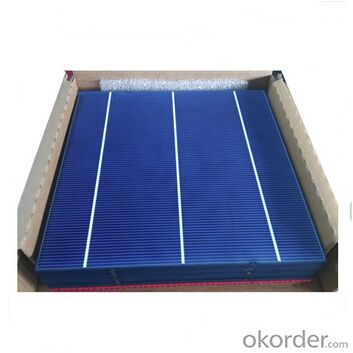
FAQ
We have organized several common questions for our clients,may help you sincerely:
①What price for each watt?
It depends on the efficiency of the solar cell, quantity, delivery date and payment terms.
②How long can we receive the product after purchase?
In the purchase of product within three working days, We will arrange the factory delivery as soon as possible. The pecific time of receiving is related to the state and position of customers.Commonly 7 to 10 working days can be served.
③Can you provide the peripheral products of the solar panels, such as the battery, controller, and inverter? If so, can you tell me how do they match each other?
Yes, we can, we have two companies for solar region, one is CNBM International, the other is CNBM engineering Co.
We can provide you not only the solar module but also the off grid solar system, we can also provide you service with on grid plant.
④What is your warranty of solar cell?
Our product can promise lower than 0.3% open box crack, we support claim after opening the box if it has crackm color difference or sth, the buyer should give pictures immediately, we can not accept the claim after the solar cell has assembled to solar panel.
• Timeliness of delivery
• ⑤How do you pack your products?
We have rich experience on how to pack the solar cell to make sure the safety on shipment, we could use wooden box or pallet as buyer's preference.
- Q: What materials are commonly used in solar cells?
- Some common materials used in solar cells include silicon, cadmium telluride, and copper indium gallium selenide.
- Q: What is the impact of tree shading on solar cell efficiency?
- Tree shading can significantly reduce solar cell efficiency as it obstructs sunlight from reaching the cells. When trees cast shadows on solar panels, the panels receive less sunlight, resulting in decreased energy generation. This shading causes a decrease in the overall output of the solar array, reducing its efficiency and potentially impacting the viability of the solar power system as a whole.
- Q: Can solar cells be used in water?
- Yes, solar cells can be used in water, but they must be specifically designed for underwater use to ensure their functionality and durability.
- Q: Can solar cells be used in residential communities?
- Yes, solar cells can be used in residential communities. In fact, they are increasingly being adopted by homeowners as a sustainable and cost-effective alternative to traditional energy sources. Solar panels can be installed on rooftops or in open spaces within residential areas, harnessing sunlight to generate electricity for individual households or even for the entire community. This not only helps reduce reliance on fossil fuels but also enables homeowners to save on energy costs in the long run.
- Q: What is the role of maximum power point tracking in solar cell systems?
- The role of maximum power point tracking (MPPT) in solar cell systems is to optimize the power output of the solar panels by continuously adjusting the operating point to the maximum power point, which is the point at which the solar panel generates the most power. MPPT ensures that the solar cell system operates at its highest efficiency, allowing for maximum energy production and improved overall performance.
- Q: Can solar cells be used in remote areas with no access to electricity?
- Yes, solar cells can be used in remote areas with no access to electricity. Solar cells harness the energy from sunlight and convert it into electricity, making them an ideal solution for areas that lack access to traditional power grids. They can be installed in remote locations to provide clean and renewable energy, enabling the communities to meet their basic electricity needs.
- Q: The working principle of solar cells includes the three processes
- The solar cells absorb photons with a certain energy and excite unbalanced carriers (photogenerated carriers) - electron - hole pairs. These electrons and holes should have sufficient life, and they will not disappear after they are separated.
- Q: Can solar cells be used in indoor applications?
- Yes, solar cells can be used in indoor applications. While solar cells primarily generate electricity from sunlight, they can also convert artificial light sources, such as fluorescent or LED lighting, into electricity. This makes them suitable for powering various indoor devices and applications, including calculators, wireless sensors, and even indoor lighting systems.
- Q: Can solar cells be used in agricultural applications?
- Yes, solar cells can be used in agricultural applications. They can be used to power various agricultural equipment such as irrigation systems, greenhouse ventilation, and livestock water pumps. Solar energy can also be harnessed to power remote farms and rural areas, reducing reliance on traditional energy sources and minimizing carbon emissions. Additionally, solar cells can be used to provide electricity for lighting, refrigeration, and other essential services in agricultural facilities.
- Q: Can solar cells generate enough electricity to power an entire house?
- Yes, solar cells have the ability to generate enough electricity to power an entire house. The size and efficiency of the solar panel system, along with the energy consumption of the house, are important factors in determining if it can meet the household's electricity needs. However, with advancements in technology and larger solar installations, it is increasingly possible for solar cells to generate sufficient electricity to power a house.
Send your message to us
Flexible Polycrystalline Solar Cells Series- 17.6%
- Loading Port:
- Shanghai
- Payment Terms:
- TT OR LC
- Min Order Qty:
- 1000 pc
- Supply Capability:
- 100000 pc/month
OKorder Service Pledge
OKorder Financial Service
Similar products
Hot products
Hot Searches
Related keywords
